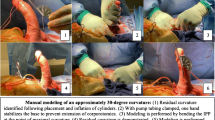Abstract
Various surgical modalities have been utilized for the treatment of penile tortuosity caused by Peyronie’s disease. However, the ideal surgical procedure has not yet been developed. Because plaque incision and grafting does not cause penile shortening, it is the best approach, particularly in cases of severe and complex penile curvature. Additionally, if the graft is nonsynthetic, neither inflammatory nor anomalous scarring will develop over time. This review suggests crural corpora cavernosa as the graft of choice, because it more closely resembles the incised area both anatomically and functionally.
Similar content being viewed by others
References and Recommended Reading
Das S: Peyronie’s disease: excision and autografting with tunica vaginalis. J Urol 1980, 124:818–819.
Helal MA, Lockhart JL, Sanford E, et al.: Tunica vaginalis flap for the management of disabling Peyronie’s disease: surgical technique, results, and complications. Urology 1995, 46:390–392.
Montorsi F, Salonia A, Maga T, et al.: Evidence based assessment of long-term results of plaque incision and vein grafting for Peyronie’s disease. J Urol 2000, 163:1704–1708.
Backhaus BO, Muller SC, Albers P: Corporoplasty for advanced Peyronie’s disease using venous and/or dermis patch grafting: new surgical technique and long-term patient satisfaction. J Urol 2003, 169:981–984.
El-Sakka AI, Rashwan HM, Lue TF: Venous patch graft for Peyronie’s disease. Part II: outcome analysis. J Urol 1998, 160:2050–2053.
Lue TF, El-Sakka AI: Venous patch graft for Peyronie’s disease. Part I: technique. J Urol 1998, 160:2047–2049.
Licht MR, Lewis RW: Modi.ed Nesbit procedure for the treatment of Peyronie’s disease: a comparative outcome analysis. J Urol 1997, 158:460–463.
Ganabathi K, Dmochowski R, Zimmern PE, et al.: Peyronie’s disease: surgical treatment based on penile rigidity. J Urol 1995, 153:662–666.
Sampaio JS, Fonseca J, Passarinho A, et al.: Peyronie’s disease: surgical correction of 40 patients with relaxing incision and duramater graft. Eur Urol 2002, 41:551–555.
Knoll LD: Use of porcine small intestinal submucosal graft in the surgical management of Peyronie’s disease. Urology 2001, 57:753–757.
Usta MF, Bivalacqua TJ, Sanabria J, et al.: Patient and partner satisfaction and long-term results after surgical treatment for Peyronie’s disease. Urology 2003, 62:105–109.
Chun JL, McGregor A, Krishnan R, et al.: A comparison of dermal and cadaveric pericardial grafts in the modified Horton-Devine procedure for Peyronie’s disease. J Urol 2001, 166:185–188.
Egydio PH, Lucon AM, Arap S: Treatment of Peyronie’s disease by incomplete circumferential incision of the tunica albuginea and plaque with bovine pericardium graft. Urology 2002, 59:570–574.
Gelbard MK, Hayden B: Expanding contractures of the tunica albuginea due to Peyronie’s disease with temporalis fascia free grafts. J Urol 1991, 145:772–776.
Kargi E, Yesilli C, Hosnuter M, et al.: Relaxation incision and fascia lata grafting in the surgical correction of penile curvature in Peyronie’s disease. Plast Reconstr Surg 2004, 113:254–259.
Teloken C, Grazziotin T, Rhoden E, et al.: Penile straightening with crural graft of the corpus cavernosum. J Urol 2000, 164:107–108.
Schwarzer JU, Muhlen B, Schukai O: Penile corporoplasty using tunica albuginea free graft from proximal corpus cavernosum: a new technique for treatment of penile curvature in Peyronie’s disease. Eur Urol 2003, 44:720–733.
Dalkin BL, Carter MF: Venogenic impotence following dermal graft repair for Peyronie’s disease. J Urol 1991, 146:849–851.
Adeniyi AA, Goorney SR, Pryor JP, et al.: The Lue procedure: an analysis of the outcome in Peyronie’s disease. BJU Int 2002, 89:404–408.
Yurkanin JP, Dean R, Wessells H: Effect of incision and saphenous vein grafting for Peyronie’s disease on penile length and sexual satisfaction. J Urol 2001, 166:1769–1772; discussion 1772–1773.
Author information
Authors and Affiliations
Corresponding author
Rights and permissions
About this article
Cite this article
Teloken, C., Teloken, P.E. & Oppermann, L. Plaque incision and grafting represents the best surgical approach to the Peyronie’s disease patient: Pro. Current Sexual Health Reports 3, 53–55 (2006). https://doi.org/10.1007/s11930-996-0002-x
Issue Date:
DOI: https://doi.org/10.1007/s11930-996-0002-x




